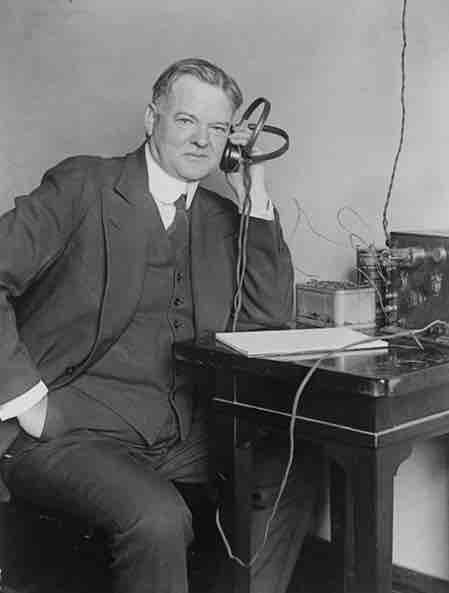Apart from a recession in 1920-1921, the 1920s saw the American economy reach a new level of industrial production and prosperity. New industries flourished, especially in the areas of electric power, automobiles, gasoline, tourist travel, and highway and housing construction. Good times were widespread for all sectors, with the exceptions of agriculture and coal mining.
Harding and Coolidge Administrations
In the U.S. presidential election of 1920, the Republican Party ran Warren G. Harding on a promise of a "return to normalcy" after the years of war, ethnic hatreds, race riots and exhausting reforms. Harding used new advertising techniques to lead the GOP to a landslide victory, carrying the major cities as many Irish, Catholics, and Germans – traditionally Democratic voters – expressed the betrayal they felt by the policies of Woodrow Wilson’s Democratic administration by deserting to the Republicans.
The fanfare was short-lived, however, as the Teapot Dome scandal tainted the reputation of the Harding administration when it was revealed in 1922 that Secretary of the Interior Albert Bacon Fall had leased U.S. Navy petroleum reserves at the Teapot Dome Oil Field in Wyoming and two other properties in California to private oil companies at favorable rates without competitive bidding. The leases themselves were not illegal, but Fall accepted bribes from Mammoth Oil and Pan American Petroleum and Transport Company to secure the deals; he was later convicted and became the first member of a presidential cabinet to be sentenced to prison.
Also in 1922, a nationwide strike by railway shopmen, which became known as the Great Railroad Strike, began under the guidance of labor organizations. Clashes with strikebreakers, shootings by armed company guards, and sabotage by strikers led to the deaths of at least ten people. Harding proposed a settlement that was rejected by the rail companies, while Attorney General Harry M. Daugherty pressed for national action against the strike. After a sweeping and highly controversial injunction by a federal judge against striking, picketing and other union activities, the railroad strike eventually faded away through local arrangements between workers and their employers. In another national controversy, Harding clashed with veterans over the issue of providing bonus payments for those who served in World War I, instead favoring a future pension system. Harding vetoed a version of an adjusted compensation act in September 1922, diminishing his overall popularity and costing him support among Republicans who saw his attempts at fiscal responsibility as endangering the party’s prospects in future elections.
Suffering exhaustion and illness believed to be brought on by the stress of the controversies, Harding died of an apparent heart attack in August 1923 during a cruise to Alaska. Vice President Calvin Coolidge succeeded Harding and in many ways could not have been more different than his predecessor. A dour, puritanical and spotlessly honest man, Coolidge’s White House stood in sharp contrast to that of Harding.
Extolling entrepreneurship, Coolidge proclaimed, "The business of America is business," and the economy flourished through and emphasis on technological efficiency and prosperity as keys to social improvement. In the Coolidge economy, energy was a key factor, especially electricity and oil. As electrification reached a growing number of cities and towns, consumers demanded new products such as light bulbs, refrigerators, and toasters. Factories installed electric motors and saw productivity surge. Oil booms in Texas, Oklahoma and California enabled the United States to dominate world petroleum production, which became even more important in an age of automobiles and trucks.
Hoover Administration
When Coolidge declined to run for reelection in 1928, the Republican Party nominated engineer and Secretary of
Herbert Hoover
, who was elected by a wide margin. Hoover believed in the efficacy of individualism and business enterprise, with limited coordination by government, to cure all problems. He envisioned a future of unbounded plenty and the imminent end of poverty in America.

Herbert Clark Hoover listening to a radio in 1925.
President Herbert Hoover advocated individualism and business enterprise, but his policies that created an economic boom enabled credit extensions and speculation that resulted in the Stock Market Crash of 1929.
The economic bubble of the late 1920s under Hoover was reflected in the extension of credit to a dangerous degree, including in the stock market, which rose to record high levels. Government size was at a very low level while at the same time government spending increased, causing greater economic freedom and prosperity. Dangerously high credit levels combined with excessive speculation in the stock market led to the Stock Market Crash of 1929. This threw the nation's economy into the Great Depression that hobbled the country in the 1930s.
The New Era of the 1920s was marked by unregulated capitalism, with the Harding and Coolidge administrations marking a return to the hands-off style of 19th-century presidents, in contrast to the activism and regulation of Theodore Roosevelt and Woodrow Wilson. Yet the dangerous practices of credit extensions, stock speculation and excessive government spending under Hoover brought the good times to a calamitous end.